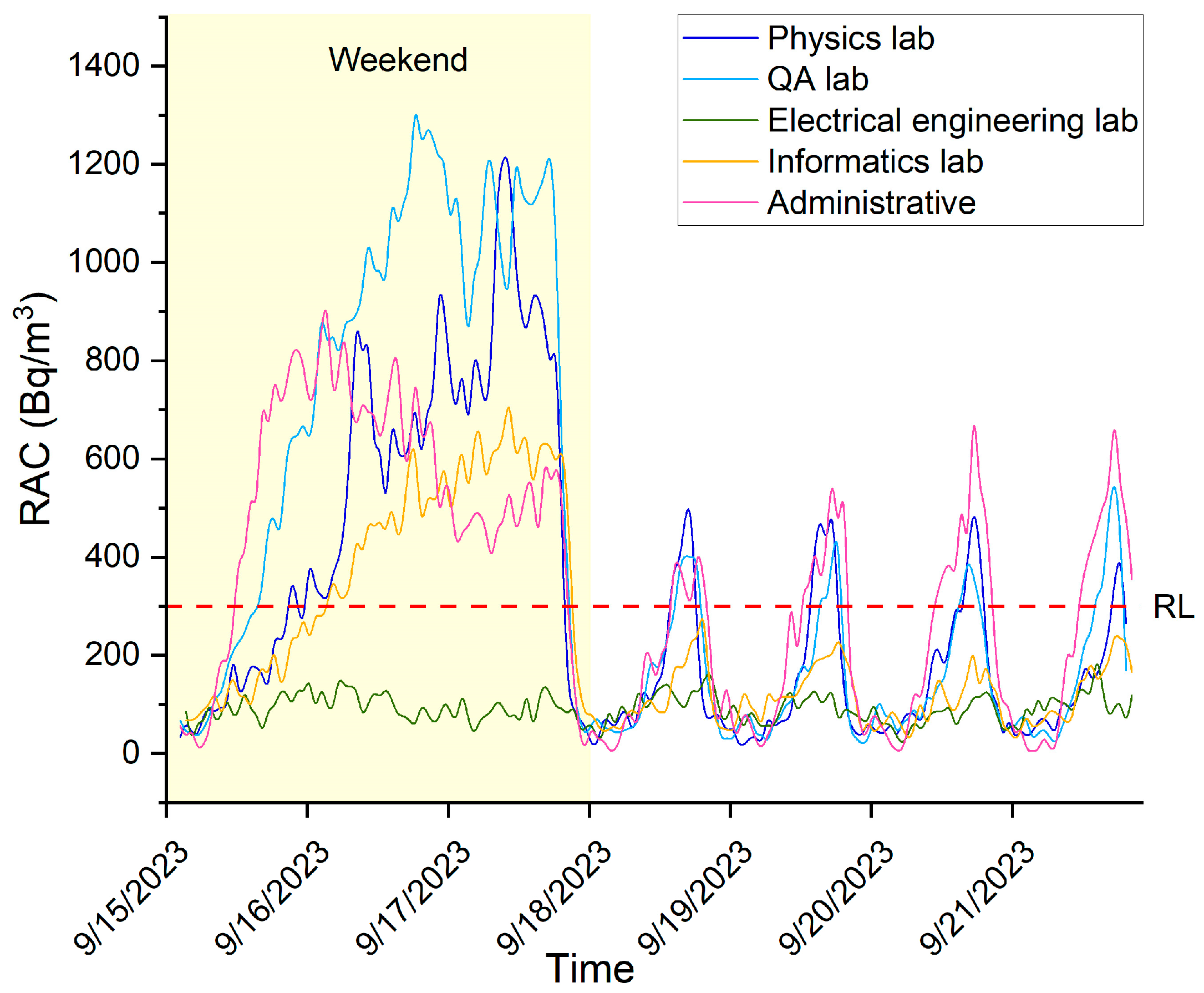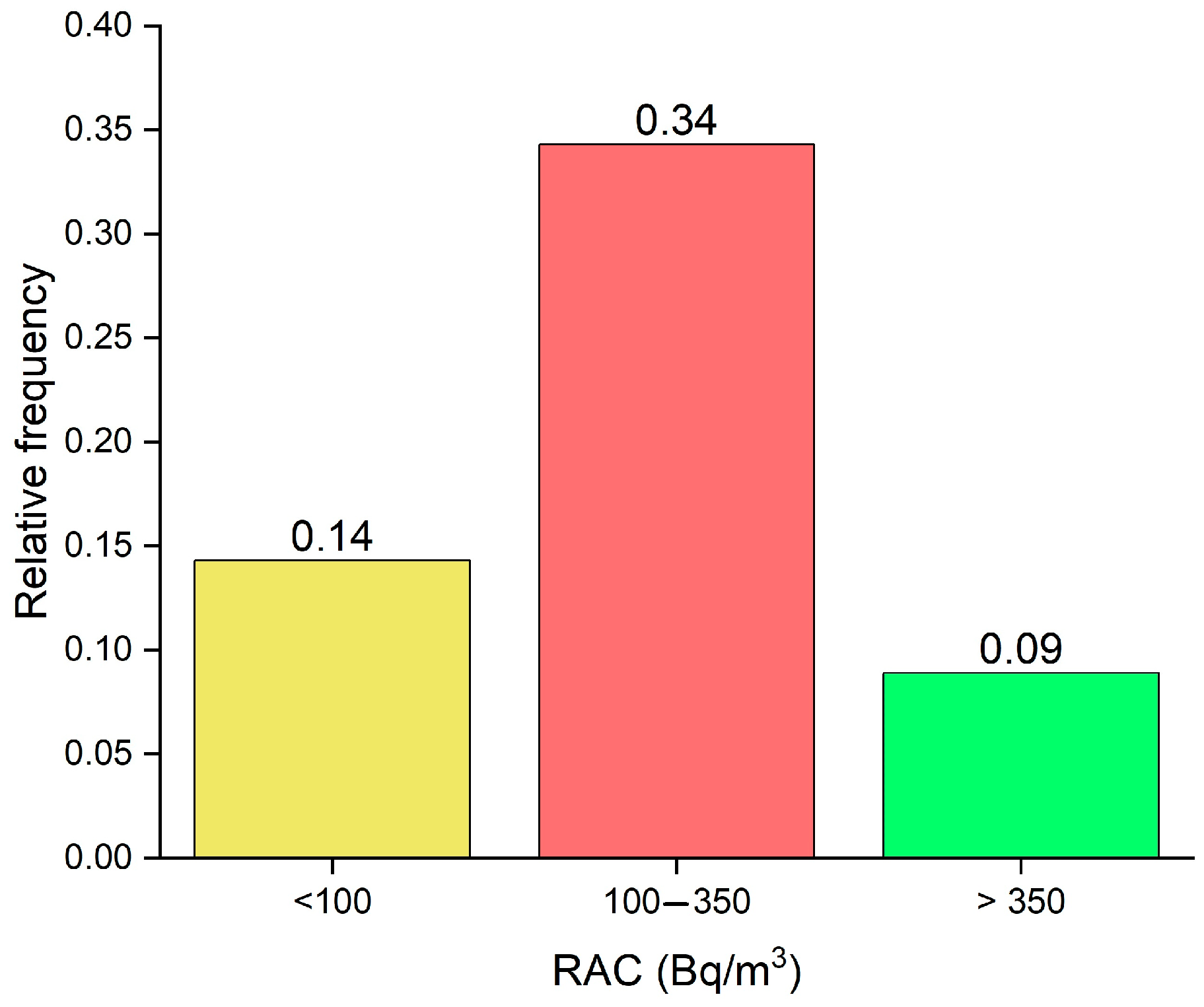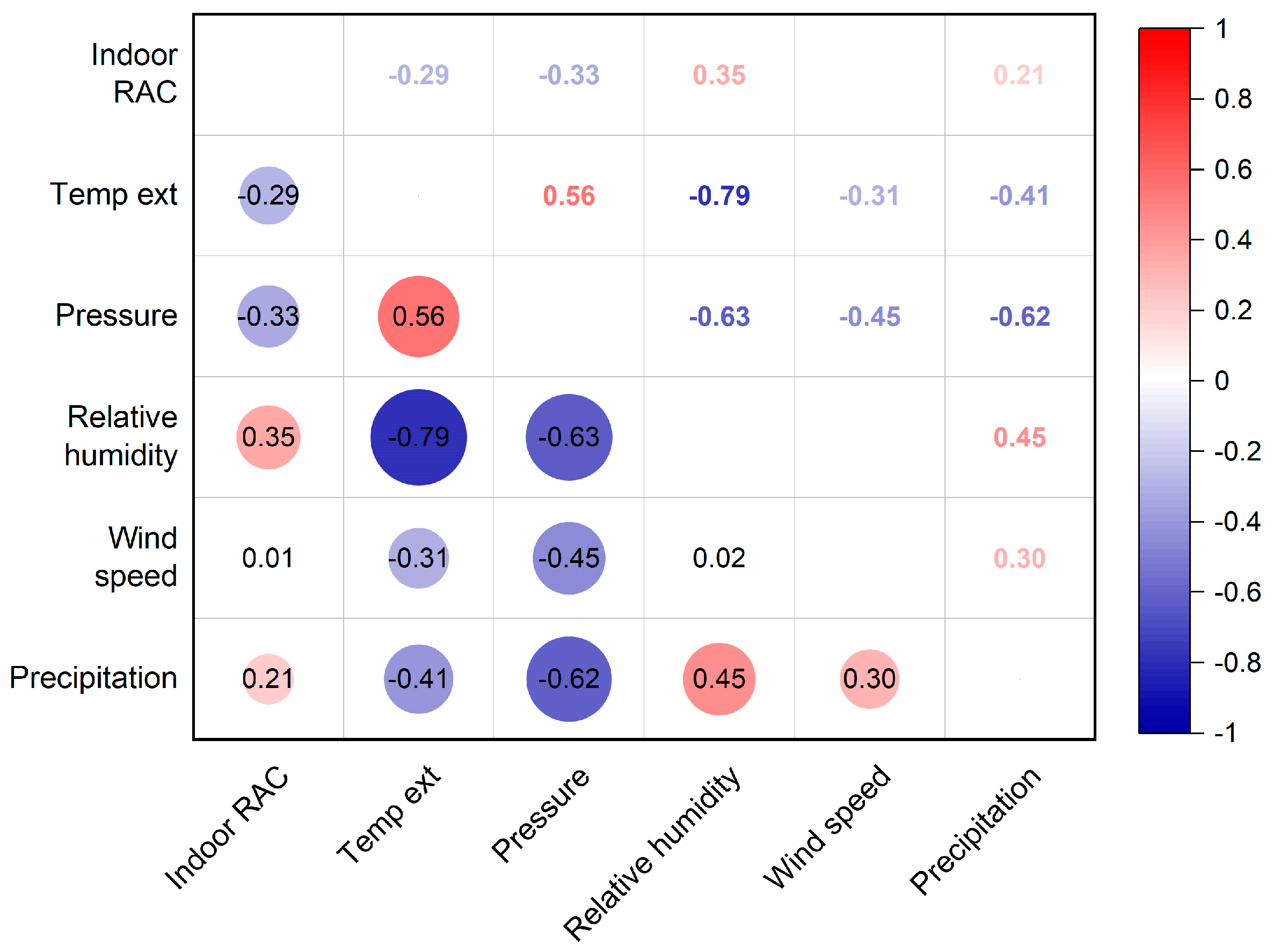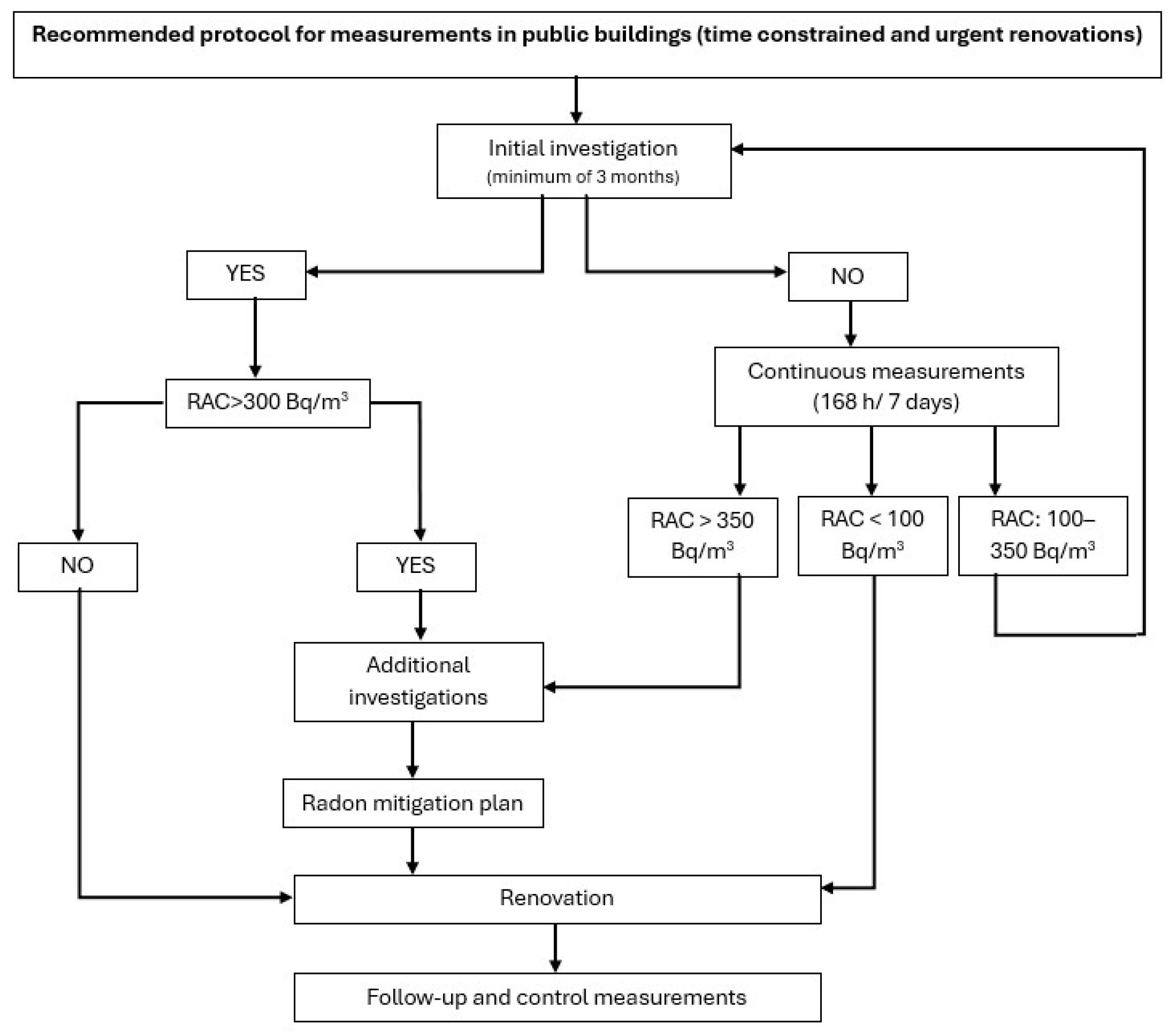Factors Influencing Radon Variability and Measurement Protocol Optimization in Romanian Educational Buildings Using Integrated and Continuous Measurements
Abstract
:1. Introduction
2. Materials and Methods
2.1. Study Parameters and Characteristics of Buildings
2.2. Work Protocol
3. Results
3.1. Initial Investigation Using Long-Term Integrated Measurements
3.2. Additional Investigation
4. Discussion
5. Conclusions
Author Contributions
Funding
Institutional Review Board Statement
Informed Consent Statement
Data Availability Statement
Conflicts of Interest
References
- Kapdan, E.; Altinsoy, N. A comparative study of indoor radon concentrations between dwellings and schools. Radiat. Phys. Chem. 2012, 81, 383–386. [Google Scholar] [CrossRef]
- Čeliković, I.; Pantelić, G.; Vukanac, I.; Krneta Nikolić, J.; Živanović, M.; Cinelli, G.; Gruber, V.; Baumann, S.; Quindos Poncela, L.S.; Rabago, D. Outdoor Radon as a Tool to Estimate Radon Priority Areas—A Literature Overview. Int. J. Environ. Res. Public Health 2022, 19, 662. [Google Scholar] [CrossRef] [PubMed]
- IARC. Man-Made Mineral Fibres and Radon. In IARC Monographs on the Evaluation of the Carcinogenic Risks to Humans; IARC: Lyon, France, 1988; Volume 43, ISBN 978-92-832-1243-0. [Google Scholar]
- The Council of the European Union. Council Directive 2013/59/Euratom of 5 December 2013 laying down basic safety standards for protection against the dangers arising from exposure to ionising radiation, and repealing Directives 89/618/Euratom, 90/641/Euratom, 96/29/Euratom, 97/43/Euratom and 2003/122/Euratom. Off. J. Eur. Union 2014, 1–73. [Google Scholar]
- ICRP. Lung Cancer Risk from Radon and Progeny and Statement on Radon; ICRP Publication: Ottawa, Canada, 2010. [Google Scholar]
- Gordon, K.; Terry, P.D.; Liu, X.; Harris, T.; Vowell, D.; Yard, B.; Chen, J. Radon in Schools: A Brief Review of State Laws and Regulations in the United States. Int. J. Environ. Res. Public Health 2018, 15, 2149. [Google Scholar] [CrossRef] [PubMed]
- Bican-Brișan, N.; Dobrei, G.-C.; Burghele, B.-D.; Cucoș, A.-L. First Steps towards a National Approach for Radon Survey in Romanian Schools. Atmosphere 2021, 13, 59. [Google Scholar] [CrossRef]
- Trevisi, R.; Leonardi, F.; Buresti, G.; Cianfriglia, M.; Cinelli, G.; Gruber, V.; Heinrich, T.; Holmgren, O.; Salvi, F.; Seri, E.; et al. Radon levels in dwellings and workplaces: A comparison with data from some European countries. J. Eur. Radon Assoc. 2022, 3, 1–13. [Google Scholar] [CrossRef]
- Carpentieri, C.; Zunic, Z.S.; Carelli, V.; Cordedda, C.; Ferrigno, G.; Veselinovic, N.; Bossew, P.; Tollefsen, T.; Cuknic, O.; Vojinovic, Z.; et al. Assessment of long-term radon concentration measurement precision in field conditions (Serbian Schools) for a survey carried out by an international collaboration. Radiat. Prot. Dosim. 2011, 145, 305–311. [Google Scholar] [CrossRef] [PubMed]
- Bochicchio, F.; Žunić, Z.S.; Carpentieri, C.; Antignani, S.; Venoso, G.; Carelli, V.; Cordedda, C.; Veselinović, N.; Tollefsen, T.; Bossew, P. Radon in indoor air of primary schools: A systematic survey to evaluate factors affecting radon concentration levels and their variability. Indoor Air 2014, 24, 315–326. [Google Scholar] [CrossRef] [PubMed]
- Ivanova, K.; Stojanovska, Z.; Tsenova, M.; Badulin, V.; Kunovska, B. Measurement of indoor radon concentration in kindergartens in Sofia, Bulgaria. Radiat. Prot. Dosim. 2014, 162, 163–166. [Google Scholar] [CrossRef] [PubMed]
- CNCAN. Order of the President of CNCAN No. 153/ 27.07.2023, May 2023. Available online: http://www.cncan.ro/assets/Radon/2023/Ordin-153-din-2023-Metodologie-radon.pdf (accessed on 13 June 2024).
- Rey, J.F.; Goyette, S.; Pernot, J.G. Weather Impacts on Indoor Radon Short-Term Measurements in Switzerland. Atmosphere 2023, 14, 1163. [Google Scholar] [CrossRef]
- Dinu, A.C.; Cosma, C.; Dicu, T.; Begy, R.; Moldovan, M.; Papp, B.; Niţă, D.; Burghele, B.; Sainz, C. Thorough investigations on indoor radon in Bǎita radon-prone area (Romania). Sci. Total Environ. 2012, 431, 78–83. [Google Scholar] [CrossRef]
- MDLPA—RTC6 Guide. Available online: http://www.cncan.ro/assets/Radon/2023/Ghid-remediere-aprobat-prin-Ordinulnr.-220192023.pdf (accessed on 22 June 2024).
- Dinu, A.C.; Papp, B.; Dicu, T.; Moldovan, M.; Burghele, D.B.; Moraru, I.T.; Tenţer, A.; Cosma, C. Residential, soil and water radon surveys in north-western part of Romania. J. Environ. Radioact. 2017, 166, 412–416. [Google Scholar] [CrossRef]
- ISO 11665-8:2019; Measurement of Radioactivity in the Environment—Air: Radon-222—Part 8: Methodologies for Initial and Additional Investigations in Buildings. International Organization for Standardization: Geneva, Switzerland, 2019. Available online: https://www.iso.org/obp/ui/en/#iso:std:iso:11665:-8:ed-2:v1:en (accessed on 4 June 2024).
- ISO 11665-5:2020; Measurement of Radioactivity in the Environment—Air: Radon-222 Part 5: Continuous Measurement Methods of the Activity Concentration. International Organization for Standardization: Geneva, Switzerland, 2020.
- ISO 11665-6:2020; Measurement of Radioactivity in the Environment—Air: Radon-222 Part 6: Spot Measurement Methods of the Activity Concentration. International Organization for Standardization: Geneva, Switzerland, 2020.
- ISO 11665-7:2012; Measurement of Radioactivity in the Environment—Air: Radon-222 Part 7: Accumulation Method for Estimating Surface Exhalation Rate. International Organization for Standardization: Geneva, Switzerland, 2012.
- Neznal, M.; Neznal, M.; Matolin, M.; Barnet, I.; Miksova, J. The New Method for Assessing the Radon Risk of Building Sites; Czech Geological Survey: Praga, Czech Republic, 2004. [Google Scholar]
- Florică, Ş.; Burghele, B.D.; Bican-Brişan, N.; Begy, R.; Codrea, V.; Cucoş, A.; Catalina, T.; Dicu, T.; Dobrei, G.; Istrate, A.; et al. The path from geology to indoor radon. Environ. Geochem. Health 2020, 42, 2655–2665. [Google Scholar] [CrossRef] [PubMed]
- Lupulescu, A.; Baciu, C.; Dicu, T.; Burghele, B.-D.; Cucoș, A.L. Determining the Geogenic Radon Potential in Different Layouts and Numbers of Points. Atmosphere 2023, 14, 713. [Google Scholar] [CrossRef]
- Cosma, C.; Dinu, A.C.; Dicu, T. Preliminary results regarding the first map of residential radon in some regions in Romania. Radiat. Prot. Dosim. 2013, 155, 343–350. [Google Scholar] [CrossRef]
- Sferle, T.; Dobrei, G.; Dicu, T.; Burghele, B.D.; Brişan, N.; Cucoş, A.; Catalina, T.; Istrate, A.; Lupulescu, A.; Moldovan, M.; et al. Variation of Indoor Radon Concentration within a Residential Complex. Radiat. Prot. Dosim. 2020, 189, 279–285. [Google Scholar] [CrossRef] [PubMed]
- Cujic, M.; Janković Mandić, L.; Petrović, J.; Dragović, R.; Đorđević, M.; Đokić, M.; Dragović, S. Radon-222: Environmental behavior and impact to (human and non-human) biota. Int. J. Biometeorol. 2021, 65, 69–83. [Google Scholar] [CrossRef] [PubMed]
- García-Tobar, J. Weather-dependent modelling of the indoor radon concentration in two dwellings using CONTAM. Indoor Built Environ. 2019, 28, 1341–1349. [Google Scholar] [CrossRef]
- Spasić, D.; Gulan, L. High Indoor Radon Case Study: Influence of Meteorological Parameters and Indication of Radon Prone Area. Atmosphere 2022, 13, 2120. [Google Scholar] [CrossRef]





| Floor Level | N* | Min. | A.M. | S.D. | Max. | Mdn. | G.M. | G.S.D. | % > RL |
|---|---|---|---|---|---|---|---|---|---|
| Basement | 10 | 84 | 447 | 295 | 892 | 438 | 342 | 2.3 | 60% |
| Ground floor | 244 | 33 | 293 | 251 | 1495 | 242 | 212 | 2.3 | 38% |
| First floor | 89 | 14 | 113 | 97 | 742 | 87 | 89 | 2.0 | 3% |
| Total | 343 | 14 | 251 | 239 | 1495 | 168 | 172 | 2.4 | 29% |
| Room Type | N | Min. | A.M. | S.D. | Max. | Mdn. | G.M. | G.S.D. |
|---|---|---|---|---|---|---|---|---|
| Administrative | 93 | 24 | 213 | 200 | 1199 | 169 | 159 | 2.1 |
| Classroom | 105 | 14 | 326 | 270 | 1495 | 257 | 224 | 2.6 |
| Laboratory | 49 | 35 | 234 | 185 | 1051 | 187 | 177 | 2.2 |
| Other | 96 | 15 | 214 | 245 | 1247 | 113 | 135 | 2.5 |
| Measurement Method | Min. | A.M. | S.D. | Max. | Mdn. | G.M. | G.S.D. | % > RL |
|---|---|---|---|---|---|---|---|---|
| Integrated | 48 | 425 | 267 | 1495 | 365 | 356 | 1.8 | 64% |
| Continuous | 43 | 377 | 265 | 1556 | 317 | 308 | 1.9 | 56% |
| Type of Investigation | N | Min. | A.M. | S.D. | Max. | Mdn. | G.M. | G.S.D. |
|---|---|---|---|---|---|---|---|---|
| Leakage (kBq/m3) | 225 | 0.2 | 2.7 | 3.0 | 35.6 | 2.0 | 1.9 | 2.2 |
| Exhalation rate (Bq/m2·h) | 37 | 0.2 | 29.6 | 32.9 | 143.8 | 20.0 | 16.4 | 3.9 |
| Type of Investigation | Min. | A.M. | S.D. | Max. | Mdn. | G.M. | G.S.D. |
|---|---|---|---|---|---|---|---|
| RAC in soil gas (kBq/m3) | 5.5 | 25.9 | 14.1 | 83.9 | 22.5 | 22.8 | 1.7 |
| RP | 5 | 24 | 14 | 75 | 22 | 21.4 | 1.7 |
Disclaimer/Publisher’s Note: The statements, opinions and data contained in all publications are solely those of the individual author(s) and contributor(s) and not of MDPI and/or the editor(s). MDPI and/or the editor(s) disclaim responsibility for any injury to people or property resulting from any ideas, methods, instructions or products referred to in the content. |
© 2024 by the authors. Licensee MDPI, Basel, Switzerland. This article is an open access article distributed under the terms and conditions of the Creative Commons Attribution (CC BY) license (https://creativecommons.org/licenses/by/4.0/).
Share and Cite
Dobrei, G.-C.; Moldovan, M.-C.; Dicu, T.; Florică, Ș.; Lupulescu, A.-I.; Țenter, A.-C.; Cucoș, A. Factors Influencing Radon Variability and Measurement Protocol Optimization in Romanian Educational Buildings Using Integrated and Continuous Measurements. Atmosphere 2024, 15, 1154. https://doi.org/10.3390/atmos15101154
Dobrei G-C, Moldovan M-C, Dicu T, Florică Ș, Lupulescu A-I, Țenter A-C, Cucoș A. Factors Influencing Radon Variability and Measurement Protocol Optimization in Romanian Educational Buildings Using Integrated and Continuous Measurements. Atmosphere. 2024; 15(10):1154. https://doi.org/10.3390/atmos15101154
Chicago/Turabian StyleDobrei, Gabriel-Cristian, Mircea-Claudiu Moldovan, Tiberius Dicu, Ștefan Florică, Alexandru-Iulian Lupulescu, Ancuța-Cristina Țenter, and Alexandra Cucoș. 2024. "Factors Influencing Radon Variability and Measurement Protocol Optimization in Romanian Educational Buildings Using Integrated and Continuous Measurements" Atmosphere 15, no. 10: 1154. https://doi.org/10.3390/atmos15101154







